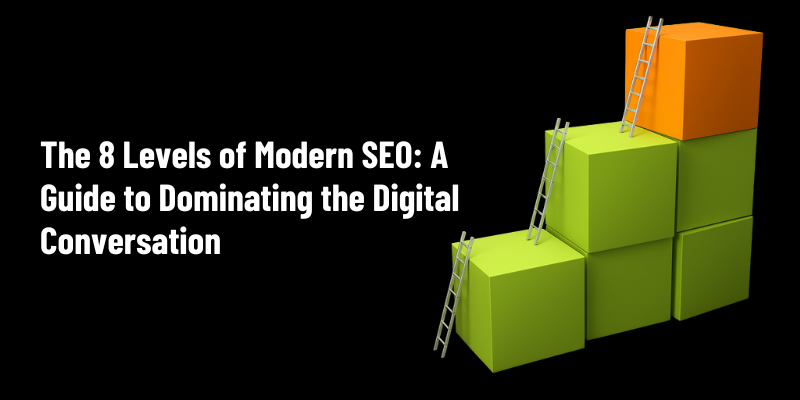The 8 Levels of Modern SEO: A Guide to Dominating the Digital Conversation

Using AI for Real-Time Fraud Detection in FinTech & E-Commerce
August 8, 2025Modern SEO is no longer just about getting to the top of search results; it’s about owning your space across the entire digital touchpoint, including search engines, AI-driven tools, paid platforms, and online communities. What worked a few years ago may not be enough today. Search algorithms have become more advanced, and users expect faster, more relevant answers than ever before. To succeed in this fast-changing environment, you need more than basic SEO. You need a complete, step-by-step strategy that covers all aspects of visibility and trust.
Think of SEO in 2025 as a journey through eight connected levels, each building on the last. The more levels you master, the stronger your digital presence becomes and the better you can handle algorithm updates and outperform your competitors.
Level 1: Traditional SEO
This is the starting point for any successful SEO strategy. Without a strong foundation, everything else will crumble. This level combines the foundational and on-page tactics that have been the backbone of search for years, ensuring Google can crawl, index, and understands your site.
- Keyword Research & Search Intent: The most critical step is understanding what your audience is searching for and why. This isn’t just about finding high-volume keywords, but about decoding user intent to create truly relevant content.
- Technical SEO: This is the unseen backbone of your website. It’s about ensuring search engines can easily crawl, index, and understand your site. This includes site speed optimization, mobile-friendliness, a logical site structure, and proper use of sitemaps.
- High-Quality, User-Centric Content: Today’s content must serve real value. Google rewards content that is original, well-written, and deeply helpful to readers. Avoid stuffing keywords, instead, focus on answering your audience’s questions thoroughly, offering solutions, and standing out with depth, clarity, and relevance.
- Meta Tags & Headings: Crafting compelling title tags and meta descriptions is crucial for a high click-through rate (CTR) in the search results. Using a clear hierarchy of headings (H1, H2, H3, etc.) not only improves readability for users but also helps search engines understand the structure and key topics of your page.
Level 2: AI Search Optimization
As search engines integrate generative AI, you must tailor your content for AI-first experiences. This means optimizing for platforms like Perplexity, You.com, and Google’s Search Generative Experience (SGE), which provide instant, synthesized answers at the top of the search results page.
- AI-First Snapshots: SGE provides a conversational, AI-generated summary at the top of the SERP, with a list of sources. To appear in this snapshot, your content must be structured, concise, and fact-based.
- Structured Data & Schema: Use schema markup like FAQ Page or HowTo to explicitly tell search engines what your content is about. This structured information is easier for AI models to parse and pull into their summaries.
- Concise Answers: Write with a natural, conversational tone and provide clear, direct answers to common questions. This format is highly usable for AI outputs.
Level 3: Paid Search Visibility
Modern SEO understands that true visibility comes from a holistic strategy that combines organic and paid efforts. Rather than seeing them as competing, think of them as synergistic.
- Test and Learn: Use paid campaigns (PPC) to quickly test which keywords, headlines, or offers work best. Use this data to improve your SEO content.
- Dominate the SERP: By having both a paid ad and a top organic ranking for the same keyword, you take up more space on the search results page, boosting brand authority and increasing your overall click-through rate.
- Full-Funnel Coverage: Paid search can capture users at the transactional stage, while organic content are perfect when someone is still researching. This combination ensures you’re visible to a user at every point in their journey.
Level 4: LLM Answer SEO
The goal of this level is to have your content become the answer in AI-generated summaries from Large Language Models (LLMs) like ChatGPT, Claude, and Gemini. This is less about driving a click and more about establishing presence and authority in a conversational context.
- Question-and-Answer Format: Structure your content to directly answer common questions. Use headings as questions and follow with a clear, concise answer.
- Structured Content: Break down complex topics into short paragraphs, bullet points, and numbered lists. This makes the information easier for LLMs to read and reproduce accurately.
- Topical Authority: Create a group of articles around a central topic. This shows comprehensive knowledge, making your content a more trustworthy source for AI models.
Level 5: Brand Authority SEO
This level is an evolution of Google’s E-E-A-T (Experience, Expertise, Authoritativeness, and Trustworthiness) guidelines. It’s about building a brand so reputable that it becomes a go-to source for search engines and users alike.
- Demonstrate Expertise & Experience: Go beyond a simple bio. Showcase your team’s real-world experience and credentials through case studies, author profiles, and firsthand accounts.
- Authoritativeness: Get a lot of good backlinks from other trusted websites. Collect positive reviews from your customers. When you are mentioned positively in the media, it shows search engines you are a credible source..
- Thought Leadership & PR: Get involved in PR and marketing efforts to become a well-known voice in your field. The more your brand is talked about positively, the more authority you build.
Level 6: Community SEO
SEO is no longer confined to websites. Community SEO involves engaging with real people on platforms like Reddit, Quora, and Discord to drive traffic, conduct keyword research, and build brand reputation.
- Active Engagement: Become a helpful, active member of relevant communities. Don’t just spam links; answer questions, provide value, and subtly link to your content when it’s genuinely helpful.
- Keyword in the Wild: These platforms are a great for understanding how your target audience talks about topics. You can discover natural, specific keywords that might not show up in traditional research tools.
- Reputation Building: By giving helpful answers on these platforms like Quora and Reddit establishes you as an expert and can lead to referral traffic and brand mentions.
Level 7: Parasite SEO
This technique involves “parasitically” using the high domain authority of an existing platform to rank for competitive keywords quickly. It’s a way to get fast visibility without waiting years to build your own authority.
- Publish on High-Authority Platforms: Create content on sites like Medium, LinkedIn, YouTube, or Product Hunt. These platforms have immense trust with search engines, allowing your content to rank faster than it would on a new website.
- Target Competitive Keywords: Use this strategy to target keywords that would be difficult to rank for on your own site. The high-authority platform gives you an instant boost.
- Drive Traffic Back: The goal is to create valuable content that ranks and then strategically link back to your own website, driving qualified traffic and building your brand.
Level 8: Platform-Specific SEO
In 2025, search happens everywhere. This level is about optimizing your content for the specific algorithms and user behaviors of different platforms.
- TikTok SEO: Use trending sounds, relevant hashtags, and engaging video hooks to get on the “For You” page. Optimize your profile with keywords and a clear link to your site.
- YouTube SEO: Optimize video titles, descriptions, and tags. Use chapters to break up your video and improve user experience, which is a ranking factor.
- Amazon SEO: For eCommerce, this means optimizing product titles, bullet points, and descriptions with relevant keywords. Creating rich, A+ content is also a key strategy.
Conclusion
By tackling these eight levels, you’re not just chasing rankings; you’re creating a strong, lasting digital presence that earns trust, drives traffic, and delivers long-term results. Your brand should not just appear; it should own the conversation everywhere your audience looks.
But here is the reality: most brands never move past Level 2. They stop at basic SEO and wonder why their growth stalls. In today’s hyper-competitive digital world, staying at Level 2 means staying invisible. To truly stand out, your brand must evolve all the way to Level 8.
At Kryobot, we build your brand’s digital dominance with full spectrum SEO system combining AI, paid media, and deep strategy for lasting visibility.

